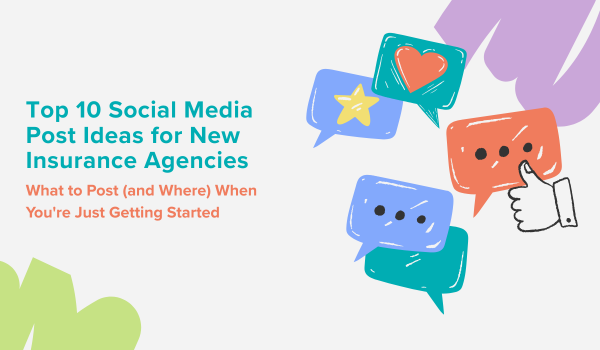Top 10 Social Media Post Ideas for New Insurance Agencies

What to Post (and Where) When You're Just Getting Started
Starting your own insurance agency is a major step. Getting the word out can feel like a whole separate full-time job. Social media is one of the best tools available to new agencies because it’s free, flexible, and helps you build trust right from the start.
The key? Don’t overthink it. You don’t need a full content strategy or expensive software to start showing up. You just need to be helpful, human, and consistent.
To make it easier, here are 10 social media post ideas, each with examples for both Facebook and LinkedIn so you can tailor your message for the audience on each platform.
1. Share Your “Why” Story
Why did you start your agency? What drives you to help people? This post builds emotional connection and trust.
Facebook: Keep it personal and casual. Include a photo of yourself.
“I started this agency because I believe insurance shouldn’t be overwhelming. I wanted to bring a personal touch to something that’s usually full of jargon and fine print.”
LinkedIn: Frame it in terms of your professional mission.
“After a decade in captive insurance, I went independent to offer better coverage options and more personalized service to clients who deserve transparency.”
2. Highlight Local Businesses and Community Connections
People trust agents who are part of the community.
Facebook: Tag a local business you love, or share an event.
“Shoutout to @Joe’s Coffee for keeping me caffeinated during client calls!”
LinkedIn: Focus on partnerships or collaborations.
“Proud to work alongside small businesses in our area. Local businesses are the heart of our economy and deserve insurance that fits their real needs.”
3. Share Bite-Sized Insurance Tips
Break down common questions into simple, easy-to-digest tips.
Facebook: Use plain language and real-life examples.
“Did you know flood damage isn't covered by your homeowner’s policy? Even if you're not in a high-risk zone, it could be worth considering.”
LinkedIn: Go deeper into the “why” and include context or data.
“With extreme weather on the rise, flood coverage is becoming a critical part of risk management. This applies even outside FEMA flood zones.”
4. Show Behind-the-Scenes Moments
Give people a peek into your day. It builds familiarity and humanizes your brand.
Facebook: Keep it light and visual.
“New business cards just came in! The little things make it feel real.”
LinkedIn: Add a business takeaway.
“Getting the back office in order is a huge part of launching a new agency. Today’s win: a clean AMS and a full coffee cup.”
5. Celebrate Client Wins (Without Sharing Personal Info)
Show how you help people — even anonymously.
Facebook:
“Helped a new homeowner understand their coverage (and its limitations) making sure they and their family are protected. These are the wins that make the long days’ worth it.”
LinkedIn:
“Case study: A contractor came to me with an insurance policy that left a major gap. We reviewed, restructured, and got him better coverage.”
6. Answer FAQs
Chances are, your audience is wondering about the same things your clients ask daily.
Facebook: Launch a series like “FAQ Fridays.”
“FAQ: Do I need uninsured motorist coverage if I have full coverage? Short answer: yes. Here’s why…”
LinkedIn: Keep it educational.
“Business owners often ask: Does my commercial auto policy cover employees using personal vehicles for work? In most cases, it doesn’t. You may need hired and non-owned auto coverage (HNOA) to close that gap and protect your business from liability.”
7. Share Reviews and Testimonials
Build credibility through real feedback.
Facebook:
Screenshot a Google review and thank the client (no names needed). Add: “Grateful for kind words like these!”
LinkedIn:
Highlight what the review says about your process or professionalism. “We pride ourselves on being responsive, and reviews like this show it’s working.”
8. Bust a Common Insurance Myth
This is great for engagement and education.
Facebook: Make it catchy.
“MYTH: Renters insurance is expensive. FACT: In [your city], it typically costs less than [insert local average] per month. It’s affordable peace of mind that covers way more than you think.”
LinkedIn: Use it to show thought leadership.
“There’s no such thing as ‘full coverage.’ It’s one of the most misunderstood phrases in insurance. It often leads to major gaps at claim time.”
9. Introduce Yourself (Even If It’s Just You)
People want to know who they’re doing business with.
Facebook:
“Hi, I’m [Name], dog mom, iced coffee fan, and the owner of [Agency Name]. I help people understand their insurance and actually feel good about it.”
LinkedIn:
Include your background and what makes you different. “I’m an independent insurance agent with a focus on education, not just sales. I help clients make smarter coverage decisions without the pressure.”
10. Offer Seasonal or Timely Reminders
These posts are helpful and position you as someone who’s paying attention.
Facebook:
“Hurricane season starts June 1. Now’s the time to check your home insurance and make sure you’re covered.”
LinkedIn:
“Business interruption insurance can be the difference between surviving and closing during a disaster. With hurricane season coming, it’s worth a second look.”
Final Tip: Always Add a Call to Action
No matter what you post, make it easy for people to take the next step:
“Have a question? Send me a message.”
“Want to review your policy? I’d be happy to help.”
“Know someone who just bought a home? Tag them!”
Social media doesn’t have to be perfect, just be mindful of E&O exposures. Focus on being real. Show up, share what you know, and be helpful. Before long, people will start seeing you as the go-to insurance pro they trust.
-1.png?width=150&height=89&name=CSIAlogo%20(2)-1.png)

